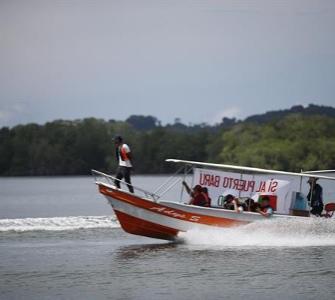In the Chiriqui province of Panama, a proposed project for the Port of Barú presents both an opportunity for economic development and a threat to coastal ecosystems. CSF evaluated the economic, social and environmental impacts of this port project for stakeholders in the region, and highlighted conflicts between the port project and Panama’s climate commitments.
The Chiriqui province of Panama is home to the country’s tallest mountains, longest rivers, and world-renowned biodiverse highland rainforests. A project to construct a new port within this province, in the Gulf of Chiriquí may threaten the environmental health of this valuable region. The proposed $200M Puerto Barú Project, while offering economic benefits such as job creation, threatens critical mangrove ecosystems essential for carbon sequestration, biodiversity, and coastal protection. (1) Among the species potentially threatened by the project are commercially important fish, bottlenose dolphins, and the northern and southern humpback whale populations in the Gulf of Chiriqui. The project plans to accommodate commercial cargo vessels, tourism activities, and a free zone. However, it will require dredging through 19.57 miles of mangroves in the Manglares de David protected area.
CSF conducted an analysis to understand the socioeconomic and environmental impacts of the Port of Barú project, including a comprehensive literature review and an economic valuation of environmental impacts. A detailed ecosystem service valuation was completed, highlighting conflicts between the port and Panama’s climate commitments. Findings supported legal challenges and strategic communications advocating for sustainable alternatives.
Key Findings
- The port's construction could result in environmental losses valued between $29.6M and $32M over 20 years, increasing to $52M–$54.6M under a more appropriate discount rate.
- Major losses include
- Soil erosion control: $22.2M
- Habitat and nursery maintenance: $3.7M
- Water flow regulation: $3.6M
- Global climate regulation: Up to $2.4M
- Environmental Impact Assessments often underestimate damages, with affected local communities, such as artisanal fishers, bearing the costs.
A related study, The Final Report for the Study on the Comprehensive Port Development Plan in the Republic of Panama (2004) identified an alternative site for the port in the Barú District in Puerto Armuelles, which boasts a number of favorable conditions for the project: government investment in developing roads, an airport, and a free zone; a maximum wave record of 1.7 feet (0.52 meters); and proximity to water with a depth of 164 feet (49.9 meters). These features create a strong, viable alternative to the planned project site. CSF integrated this data in our analysis of potential alternative sites for this development project.
One significant challenge highlighted in the Puerto Barú study is the lack of comprehensive, long-term research on the environmental and socioeconomic impacts of port construction. While ports play a crucial role in economic development, detailed studies tracking the extended consequences of such projects—spanning decades—are scarce. This gap in data makes it difficult to fully understand how large-scale developments affect biodiversity, local economies, and community livelihoods over time. The absence of longitudinal studies leaves critical questions unanswered, such as the cumulative impacts on ecosystem health and the long-term viability of traditional livelihoods like artisanal fishing. Addressing this shortfall requires a concerted effort to implement long-term evaluations, ensuring that infrastructure projects are planned with a robust understanding of their full lifecycle impacts.
This project exemplifies the importance of integrating environmental and economic analyses into infrastructure planning to better balance development and sustainability outcomes.
__
Data Source (1) : https://www.nature.org/en-us/about-us/where-we-work/united-states/florida/stories-in-florida/why-mangroves-important/#:~:text=The%20complex%20mangrove%20root%20systems,the%20estuarine%20and%20ocean%20environment
Photo Source: Ensegundos.com.pa

